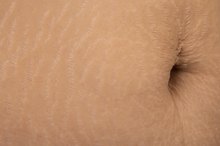What does fact checked mean?
At Healthfully, we strive to deliver objective content that is accurate and up-to-date. Our team periodically reviews articles in order to ensure content quality. The sources cited below consist of evidence from peer-reviewed journals, prominent medical organizations, academic associations, and government data.
The information contained on this site is for informational purposes only, and should not be used as a substitute for the advice of a professional health care provider. Please check with the appropriate physician regarding health questions and concerns. Although we strive to deliver accurate and up-to-date information, no guarantee to that effect is made.
What Should You Do if You Are Losing Weight But Getting Flabby?
Flabby skin is composed of three components -- fat, loose skin and loose muscle. Exercise may alleviate fat and loose muscle, but the skin is a more difficult problem to get rid of. To get rid of the skin, medical intervention is required. However, losing some fat and building up your muscles will help skin look a bit firmer.
Fat
Your body stores excess calories as fat. The more fat stored, the more fat cells your body may create. Depending on a person's gender and genetics, these pockets of fat are usually around the mid-section, hips and buttocks. After losing large amounts of weight, these pockets of fat may prove to be difficult to lose because they still contain a number of excess fat cells. Plastic surgery is always an option.
- Your body stores excess calories as fat.
- After losing large amounts of weight, these pockets of fat may prove to be difficult to lose because they still contain a number of excess fat cells.
Fat Pocket Reduction
How to Remove Skin Tags with Tea Tree Oil
Learn More
It is not uncommon for pockets of flab to persist even after significant weight loss. Liposuction is the minimally invasive surgical procedure that can help alleviate these pockets 3. Liposuction is conducted with an aspirator to suction out fat through a small incision near the pocket of fat. Liposuction procedures remove only small amounts of fat to prevent sagging skin.
- It is not uncommon for pockets of flab to persist even after significant weight loss.
- Liposuction is conducted with an aspirator to suction out fat through a small incision near the pocket of fat.
Excess Skin
As a person gains weight, her skin begins to stretch by adding skin cells. These skin cells do not disappear as you begin to lose weight. The excess skin will continue to be present even after the excess weight is lost. This skin turns into flabby folds of skin. If your skin has good elasticity, these folds are minimal, but if your skin's elasticity is bad, you will notice a considerable build-up of excess skin.
- As a person gains weight, her skin begins to stretch by adding skin cells.
- The excess skin will continue to be present even after the excess weight is lost.
Prevention and Treatment
Fast Ways to Lose 100 Pounds Safely
Learn More
Excess skin can be prevented by losing weight at a stable rate. Any weight loss that averages more than two pounds a week is considered too fast by the experts at the Weight-Control Information Network. Losing more than 3 pounds a week for more than a couple weeks also increases your risk for gallstones, and the WCIN also reports that a diet of less than 800 calories per day may increase your risk of heart disease. A stable and steady weight loss allows your skin to slowly contract and retain most of its elasticity. If the loose skin is already present, surgery is required. An abdominoplasty will remove loose skin from your mid-section. A thigh lift is a procedure that will remove excess skin from around your thighs. These procedures are performed under general anesthesia. During this procedure, large incisions are made, after which excess skin is cut away. These procedures last two to four hours. Full recovery from these procedure takes three to six months.
- Excess skin can be prevented by losing weight at a stable rate.
- Any weight loss that averages more than two pounds a week is considered too fast by the experts at the Weight-Control Information Network.
Related Articles
References
- Physiology 5th Edition; Mathew N. Levy, Robert Bern, Bruce Koeppen and Bruce Stanton
- Dermatology and Venerology; S.T.Pavlolv, O.K.Shaposhnikov, V.I.Samcov, I.I.Ilyin and K.R. Babayan
- American Society of Plastic Surgeons: Liposuction Procedure
- Langer V, Singh A, Aly AS, Cram AE. Body contouring following massive weight loss. Indian J Plast Surg. 2011;44(1):14-20. doi:10.4103/0970-0358.81439
- Boswell CB. Body contouring following massive weight loss. Mo Med. 2010;107(3):189-94.
- Elander A, Biörserud C, Staalesen T, Ockell J, Fagevik olsén M. Aspects of excess skin in obesity, after weight loss, after body contouring surgery and in a reference population. Surg Obes Relat Dis. 2019;15(2):305-311. doi:10.1016/j.soard.2018.10.032
Writer Bio
Dr. Robert Petros has been working at the Yerevan State Medical University Department of Epidemiology and Infectious Diseases since 2009. He has had experience with thousands of patients and done a considerable amount of work in epidemic prevention on the government level.









